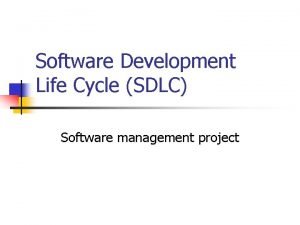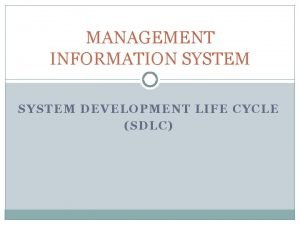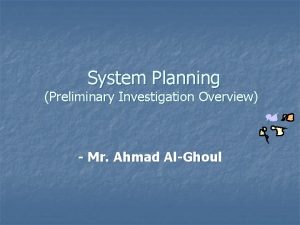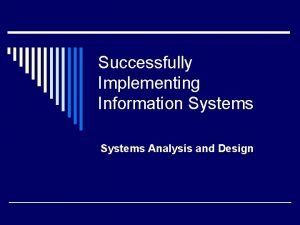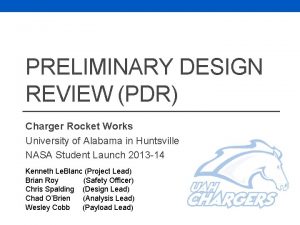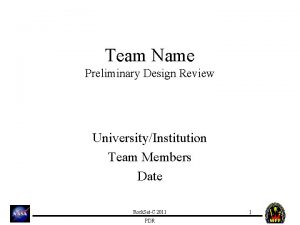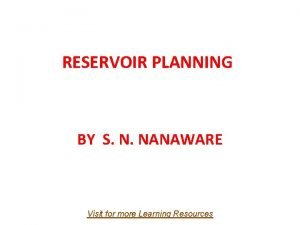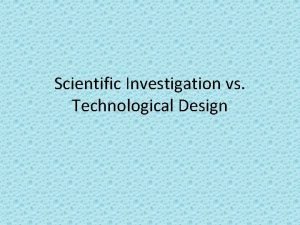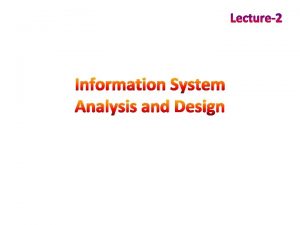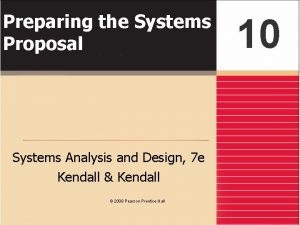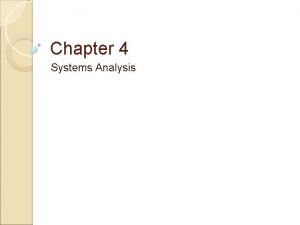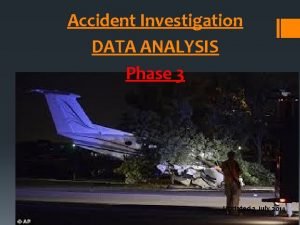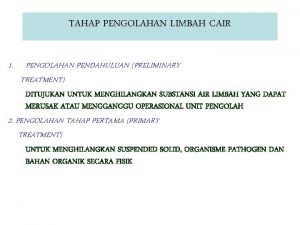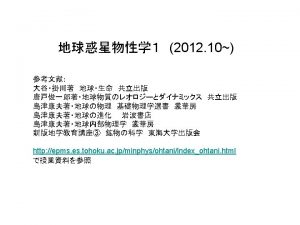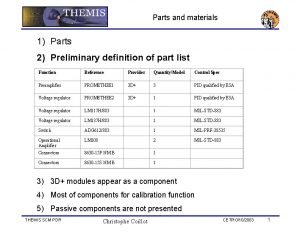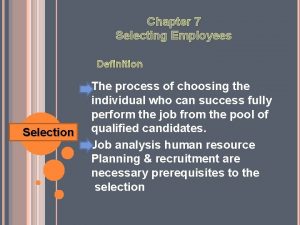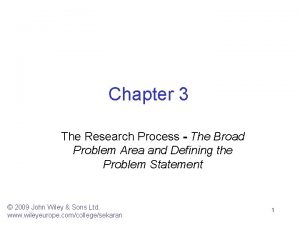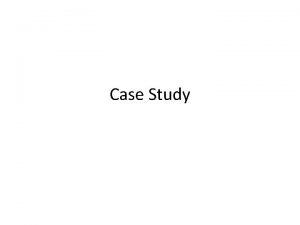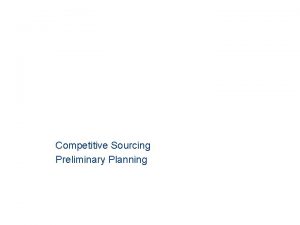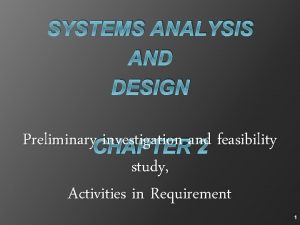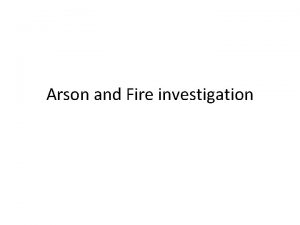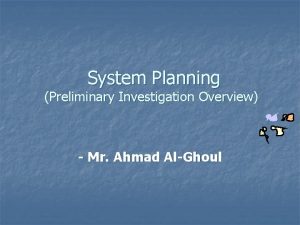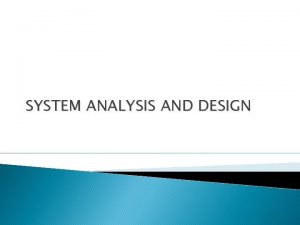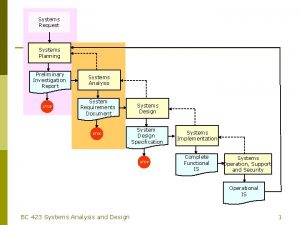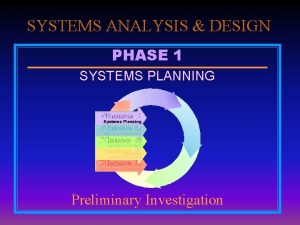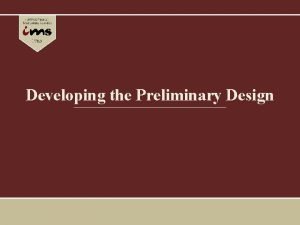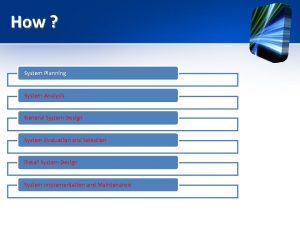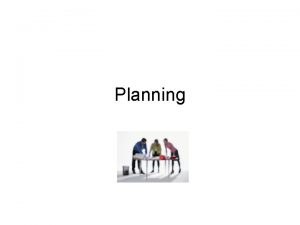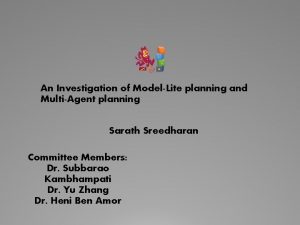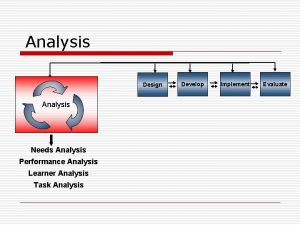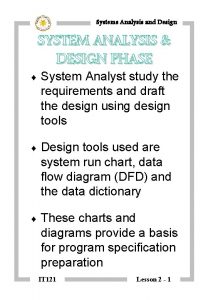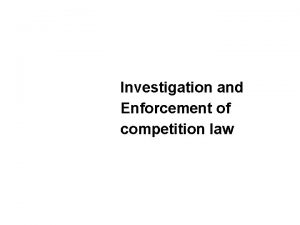System Analysis and Design System Planning Preliminary Investigation






























![Reference n [1] System Analysis and Design, Sixth Edition (Chapter 2 ) Authors: Gary Reference n [1] System Analysis and Design, Sixth Edition (Chapter 2 ) Authors: Gary](https://slidetodoc.com/presentation_image_h2/65261413d90d51f43775b553c19ffd53/image-31.jpg)
- Slides: 31

System Analysis and Design System Planning (Preliminary Investigation Overview) Prof. Amandeep Kaur

Learning Objectives n Describe the steps in a preliminary investigation and the end product of an investigation System Analysis and Design System Planning 2

What is System Planning? • • • Is always performed with Senior management. Is used to study an Organization’s information needs, strategic opportunities and develop a plan to address those needs. Is a methodical approach to the formation of plans and programs for safe and efficient system.

What it includes? • • • Setting of goals and objectives. Collection of data of existing conditions. Formulation of alternative planned changes. The decisions about recommendations that are feasible , desirable and appropriate. More comprehensive plan with a relatively predictable environment.

Benefits of system planning • • Enable senior management to view the enterprise in terms of key business functions and data. Identifies information and systems needed to support the Business priorities. Sets Priorities and expectations for system projects. Establish a technology platform and a framework for information systems development.

What is initial investigation? • • • Initial investigation is the first step in the analysis of project. It is the fact finding mission in which you aim to find out as much as you can about your user , current problem and what the user needs from a computer system. It is difficult to create an appropriate and useful computer system without user intervention. Avicenna System Analysis and Design System Planning 6

It enables to outline n n Background to the problem /identify the problem. Identify the user having the problem. Outline the limitations of the solution you purpose. Choose the best way of providing a solution and explain why it is the best way. Avicenna System Analysis and Design System Planning 7

Determining the user’s information requirements. n n n The information analyst determines the needs of the user and the information flow that will satisfy those needs. The usual approach is to ask the user that information is currently available and what information is required. Interaction between analyst and the user usually leads to an agreement about what information will be provided by the candidate system. Avicenna System Analysis and Design System Planning 8

Types of methods to explain the requirements to the system analyst. n 1. Kitchen sink: In this strategy the user throws everything into the requirement definition - overstatement of needs such as an overabundance of reports, exception processing and the like. This approach usually reflects the user’s lack of experience in the area. 2. The smoking strategy: This strategy sets up a smoke screen by requesting several system features when only one or two are needed. The extra requests are used as bargaining power. This strategy usually reflects the user’s experience in knowing what he/she wants. Requests have to be reduced such that they are manageable, realistic and achievable. 3. The same thing strategy: This strategy indicates the user’s laziness, lack of knowledge, or both. ” Give me the same thing but in a better format through the computer” is a typical statement. The analyst has very little chance of succeeding because the user is not capable of identifying the problems in detail. Avicenna System Analysis and Design System Planning 9

Strategies for determining information requirements Three approaches: • Asking • Getting information from the existing system • prototyping Avicenna System Analysis and Design System Planning 10

Asking n 1. Questions: Questions may be open-ended or closed. An open-ended question allows the respondent to formulate a response. It is used when feelings or opinions are important. A closed question requests one answer from a specific set of responses. It is used when factual responses are known. 2. Brainstorming: Brainstorming is a technique used for generating new ideas and obtaining general information requirements. This method is appropriate for getting non conventional solutions to problems. A guided approach to brainstroming asks each participant to define ideal solutions and then select the best one. It works well for users who have sound system knowledge but have the difficulty of accepting new ideas. 3. Group consensus: This method asks participants for their expectations regarding specific variables. Each participant fills out a questionnaire. The results are summarized and given to participants along with a follow-up questionnaire. Participants are invited to change their responses. The results are again summarized and given back to the participants. This debate by questionnaire continues until participants responses have converged enough. This method is advantageous than brainstorming because the participants are not subjected to psychological pressure. Avicenna System Analysis and Design System Planning 11

GETTING INFORMATION FROM EXISTING INFORMATION SYSTEM n n n 1. Data Analysis approach Determining information from an existing application is called the data analysis approach. It simply asks the user what information is currently received and what other information is required. It depends on the user for getting accurate information. The analyst examines all reports, discusses each piece of information with the user, and determines unfulfilled information needs by interviewing the user. The analyst is primarily involved in improving the existing flow of data to the user. A major drawback is a lack of established rules for obtaining and validating information needs that are not linked to organizational objectives. Avicenna System Analysis and Design System Planning 12

n n n 2. Decision Analysis This method breaks down a problem into parts, which allows the user to focus separately on the critical issues. It also determines policy and organizational objectives relevant to complete each major decision. The analyst and the user then refine the decision process and the information requirements for a final statement of information requirements. In this method information needs are clearly linked to decision and organizational objectives. It is useful for unstructured decisions and information tailored to the user’s decision-making style. The major drawback is that information requirements may change when the user is promoted or replaced Avicenna System Analysis and Design System Planning 13

PROTOTYPING n The third strategy for determining user information requirements is used when the user cannot establish information needs accurately before the information system is built. The reason could be the lack of an existing model on which to decide requirements or a difficulty in visualizing candidate system. This iterative approach first set up the initial requirements and builds a system to meet these requirements. As users gain experience, they request additional requirements or modifications and the process continues. Prototyping is suitable for environments where it is difficult to formulate a concrete model for defining information requirements. Prototyping strategy is appropriate for determining high uncertainty information requirement. Avicenna System Analysis and Design System Planning 14

Kinds of information Required n Information of the firm Information about the organization's policies , goals , objectives, Structure explain the kind od information system required. n Information about the user staff Information about the people who run the system, their job functions and information requirements , the relationship of their jobs to the existing system Avicenna System Analysis and Design System Planning 15

n Information about the work flow The workflow focus on what happens to that data through various points in the system. This can be shown through data flow diagram. Avicenna System Analysis and Design System Planning 16

Needs System analysis Data Gathering The system analyst Collects the data about the System to be developed. n Written Documents Analyst may collect the data from written documents available from manuals of the organization. Documents may be reports, memos, business plans etc. n Avicenna System Analysis and Design System Planning 17

n Questionnaires are feedback forms used to collect the information. It is very convenient and inexpensive method to collect information. n Interviews The Analyst interviews the managers, users , clients, Suppliers and competitors to Collect the information. n Observations In this technique analyst the working, behavior, and other related information Avicenna System Analysis and Design System Planning 18

Fact Findings Methods n n n Fact-finding involves various techniques In order to study any system the system analyst needs to do collect fact and related data. Various fact finding methods like interview, Questionnaire, Record View , Observations and other various techniques Depending on what information is needed to investigate the systems request, fact-finding might consume several hours, days, or weeks Analyze Organization Charts n n Avicenna Obtain organization charts to understand how the department functions Organization charts show formal reporting relationship but not the informal alignment of a group System Analysis and Design System Planning 19

1. Interviews n n n Avicenna Determine the people to interview. Establish objectives for the interview. Develop interview questions. Prepare for the interview. Conduct the interview. Document the interview. Evaluate the interview. The purpose of the interview, is to uncover facts, not convince others that the project is justified In an interview ask effective questions Include open ended questions You should interview managers and supervisors who have a broad knowledge of the system You might talk to operational personal to learn how the system functions on day-to-day basis System Analysis and Design System Planning 20

Types of Interviews n Step 3: Perform Fact-Finding n Review documentation n n Observe operations n n n To see how workers carry out typical tasks To follow the actual paths taken by input source documents or output reports Conduct a user survey n n Avicenna To learn more about the current system To get information from a larger group Design a form that users complete It is not flexible as interview Less expensive, less time, and can involve a broad crosssection of people System Analysis and Design System Planning 21

Preliminary Investigation Overview n Step 4: Evaluate Feasibility n Avicenna Evaluate the project’s operational, technical, economic, and schedule feasibility System Analysis and Design System Planning 22

Preliminary Investigation Overview n Step 5: Estimate Project Development Time and Cost What information must you obtain, and how will you gather and analyze the information? n What sources of information will you use, and what difficulties will you encounter in obtaining information? n Avicenna System Analysis and Design System Planning 23

Preliminary Investigation Overview n Step 5: Estimate Project Development Time and Cost n n Avicenna Will you conduct interviews? How many people will you interview, and how much time will you need to meet with the people and summarize their responses? Will you conduct a survey? Who will be involved? How much time will it take people to complete it? How much time will it take to prepare it and tabulate the results? System Analysis and Design System Planning 24

Preliminary Investigation Overview n Step 5: Estimate Project Development Time and Cost How much will it cost to analyze the information gathered and to prepare a report with findings and recommendations? n You should provide an estimate for the overall project, so managers can understand the full cost impact and timetable n Avicenna System Analysis and Design System Planning 25

Preliminary Investigation Overview n Step 6: Present Results and Recommendations to Management The final task in the preliminary investigation is to prepare a report to management n The format of the preliminary investigation report varies from one company to another n The report includes an evaluation of system request, an estimate of costs and benefits, and your recommendation n Avicenna System Analysis and Design System Planning 26

Preliminary Investigation Overview n Step 6: Present Results and Recommendations to Management n Introduction n n Systems request summary n n It contains the results of the preliminary investigation Recommendations n Avicenna It describes the basis of the system request Findings n n It contains a brief description of the system, the name of the person or group who performed the investigation, and the name of the person or group who initiated the investigation Recommendations for further action, with specific reasons and justification System Analysis and Design System Planning 27

Preliminary Investigation Overview Step 6: Present Results and Recommendations to Management n Project Roles n n Time & cost estimates n n Anticipated tangible and intangible benefits and a timetable that shows when they are to occur Appendix n Avicenna This section describes the cost of acquiring and installing the system, and the total cost of ownership during the system’s useful life Expected benefits n n Lists the people who will participate in the project, and describes each person’s role It included in the report for supporting information System Analysis and Design System Planning 28

Sequence Summary n During the third step in preliminary investigation, the analyst perform fact-finding n n n Fact-finding involves various techniques such as Analyze Organization Charts, interviews, Review documentation, and Conduct a user survey During the fourth step in preliminary investigation, the analyst evaluate the project’s operational, technical, economic, and schedule feasibility During the fifth and sixth steps, the analyst estimate project development time and cost; and present results and recommendations to management Avicenna System Analysis and Design System Planning 29

Sequence Summary n In this Sequence we have n n n Avicenna Described the third step in preliminary investigation that describe how to perform fact-finding Described the interviews technique Defined other fact finding techniques, document review, user observation, and survey Described the fourth step in preliminary investigation that describe how to evaluate feasibility Described the fifth step in preliminary investigation that describe how to estimate project development time and cost Described The final task in the preliminary investigation that describe how to prepare a report to management System Analysis and Design System Planning 30
![Reference n 1 System Analysis and Design Sixth Edition Chapter 2 Authors Gary Reference n [1] System Analysis and Design, Sixth Edition (Chapter 2 ) Authors: Gary](https://slidetodoc.com/presentation_image_h2/65261413d90d51f43775b553c19ffd53/image-31.jpg)
Reference n [1] System Analysis and Design, Sixth Edition (Chapter 2 ) Authors: Gary B. Shelly, Thomas J. Cashman and Harry J. Rosenblatt , n Publisher: SHELLY CASHMAN SEWIES. n Avicenna System Analysis and Design System Planning 31
 Software
Software Sdlc introduction
Sdlc introduction System planning and initial investigation
System planning and initial investigation Disaster recovery planning in system analysis and design
Disaster recovery planning in system analysis and design Preliminary design review example
Preliminary design review example Pdr preliminary design review
Pdr preliminary design review Preliminary design review template
Preliminary design review template What is input output design
What is input output design Investigation for reservoir planning
Investigation for reservoir planning User interface design in system analysis and design
User interface design in system analysis and design Dialogue design
Dialogue design Technological design and scientific investigation
Technological design and scientific investigation Dfd advantages and disadvantages
Dfd advantages and disadvantages Fact finding methods in system development
Fact finding methods in system development Organizational feasibility in system analysis and design
Organizational feasibility in system analysis and design Shower approach in international marketing
Shower approach in international marketing Preliminary cooking and flavoring
Preliminary cooking and flavoring Vce extended investigation
Vce extended investigation Characteristics of system in sad
Characteristics of system in sad System security in system analysis and design
System security in system analysis and design Title proposal for system analysis and design
Title proposal for system analysis and design Problem definition in system analysis and design
Problem definition in system analysis and design Accident investigation data analysis
Accident investigation data analysis Preliminary budget
Preliminary budget Preliminary treatment adalah
Preliminary treatment adalah Preliminary survey audit
Preliminary survey audit P 波
P 波 Parts of preliminaries
Parts of preliminaries Mla rough draft example
Mla rough draft example Preliminary interview
Preliminary interview Broad problem area adalah
Broad problem area adalah Gayne corporation's contribution margin ratio
Gayne corporation's contribution margin ratio
